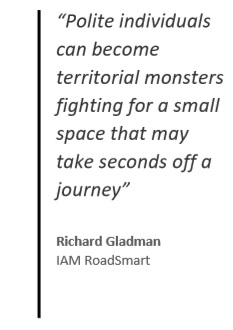
As part of its ‘Thumbs Up For Great Driving And Riding!’ campaign, IAM RoadSmart has published six tips to help road users safely share the road with each other.
The ‘Thumbs Up’ campaign is running throughout August and encourages road users to show their appreciation for courteous driving behaviour – such as thanking a driver for giving way – with a simple thumbs up.
Throughout the month, IAM RoadSmart staff and volunteers are watching out for good deeds committed by drivers and riders and handing out thousands of stickers in support of the campaign.
 As part of the initiative, Richard Gladman, IAM RoadSmart’s head of driving and riding standards, has issued the following tips to help road users behave courteously towards each other:
As part of the initiative, Richard Gladman, IAM RoadSmart’s head of driving and riding standards, has issued the following tips to help road users behave courteously towards each other:
- Look ahead and predict what other road users may be doing; be ready to react and change your speed if necessary
- Try to see the world through the eyes of others and help them, without them even realising it
- Give way; a large vehicle, such as an HGV or a bus, will need extra room when turning
- Allow extra room; motorcyclists can sometimes been seen filtering through traffic
- Know when to overtake; be patient and overtake when the time is right, if you have to follow for a while then leave a sensible space
- Be respectful when passing horses; make sure you give the rider enough space when passing them
Richard Gladman said: “Our behaviour towards others often changes when driving. Polite individuals can become territorial monsters fighting for a small space that may take seconds off a journey; this competitive attitude can ramp up stress levels.
“Remember, until you walk – or in this case drive – a mile in another man’s shoes, you won’t appreciate that driving is much better if we share nicely.
“A big ‘Thumbs Up’ to enjoying the sunshine and appreciating the polite waves and smiles you can now collect on your journey.”
Drivers and motorcyclists can get involved with the campaign by sharing their own positive driving and riding experiences on social media using the hashtag #ThumbsUpForGreatDriving or #ThumbsUpForGreatRiding.
Thanks Bob. It was a long day and irony wasn’t being recognised.
You have my apologies.
Iain, Edinburgh
+3
Hugh and Iain. You are both right. That is the point that I was making. I was being ironic. There is a report that does state that so called Advanced motorists often after being so trained to make overtakes and in general drive at higher speed round bends etc. have a preponderance to drive faster than the ordinary motorists all the time and that is as you and I believe should not happen….but if does.
Those few words were added by Mr Gladman to placate their IAM membership readers, to basically say its ok to overtake for our members as they have received proper training. We all know that that should not be the case. Its never ok to break the law or to sacrifice safety for the sake of any other consideration. In the case of making fast progress.
R.Craven
+1
After 50 years driving Bob, I don’t recall ever having overtaken another vehicle (on a single c/way road anyway, which I presume is the context) – does that make me a non-advanced driver or just disciplined and sensible? Give a title of ‘advanced driver/rider’ to someone and it might lead them to take unnecessary risks… such as overtaking!
Hugh Jones
--2
Oh dear Mr Craven, unfortunately I haven’t got any advanced training. I must remember that I can not overtake any more because I must be inherently dangerous and not as “advanced” as some other drivers. Here I thought that common sense would get me through.
I’ve also started to drink cold coffee, at least until I can get on an advanced handling hot liquids course.
Iain, Edinburgh
+4
I agree Hugh… It should read ‘Know when to overtake and when not to consider an overtake’ in which case it best to drop back to the safer following on position. Only overtake when it is completely safe to do so and one is not breaking the law in doing so.
As you say many overtakes are unnecessary and many are indeed at an inappropriate speed or sometimes in excess of the speed limit.
Then again whats the point in being trained in advanced techniques if one cannot benefit from that training and use the whole of the road and the capability of the machine and of oneself. That’s probably why the last part was included Hugh… for the sake of those drivers and riders that have been properly trained in the art of what may be called or considered a lawful overtake. Advanced road users.
R.Craven
0
Reading their list from top to bottom, it gets off to a good start “Look ahead and predict…etc” quite right – but then further down it says “Know when to overtake..” – why even mention something potentially risky (and usually unnecessary anyway), amongst a list of otherwise sensible, defensive driving messages?
Hugh Jones
--3
Agree, Bob.
Nigel ALBRIGHT
+1
At least 4 out of 6 pieces of advice mention the giving of more space. That’s a good start. If more drivers gave more space then our roads would be a safer place for all.
R.Craven
+1